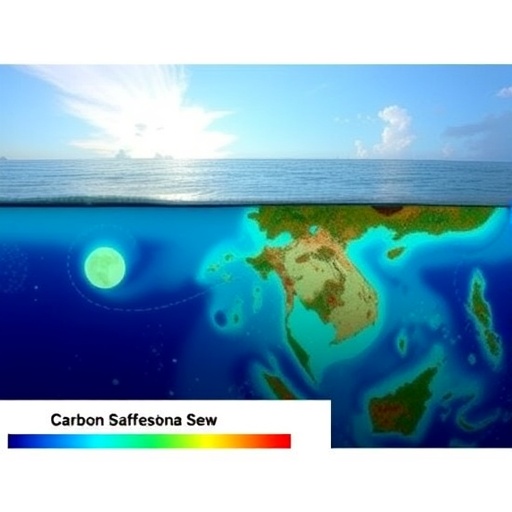Recent advancements in the realm of carbon capture technology have brought renewed hope to the battle against climate change. Among these advancements, the innovative research conducted by Liu, Mohammadian, and Azdarpour, as presented in their forthcoming publication, serves as a beacon of potential for addressing global carbon emissions. Their study, situated within the rich marine ecosystem of the South China Sea, leverages both experimental approaches and geochemical modeling to enhance the efficiency of carbon dioxide mineralization, a process pivotal for sustainable carbon sequestration.
The urgency of mitigating climate change remains critical, primarily due to the escalating levels of atmospheric carbon dioxide resulting from industrialization and human activities. Researchers and scientists around the globe are tirelessly seeking ways to arrest this trend, with carbon dioxide mineralization emerging as a promising avenue. The ability to convert carbon dioxide gas into solid mineral forms not only prevents its re-entry into the atmosphere but also helps to permanently store this greenhouse gas, ensuring a healthier planet for future generations.
The research team’s strategic choice of the South China Sea as their study site is particularly noteworthy. This region, known for its diverse marine environments and geological formations, possesses unique characteristics that facilitate the mineralization process. The combination of seawater chemistry and geological substrates provides the ideal conditions for the natural reaction between carbon dioxide and minerals, significantly enhancing the mineralization capacity. Their findings reveal how these natural processes can be harnessed and optimized, providing a crucial link between research and application.
In their groundbreaking work, the researchers meticulously integrated experimental data with advanced geochemical modeling. This dual approach is critical in distinguishing the optimal conditions that maximize the effectiveness and efficiency of carbon dioxide mineralization. By employing both methods, the researchers were able to simulate various scenarios, analyzing the interaction of pH levels, temperature, and mineral availability. Such detailed modeling allows for a comprehensive understanding of how these factors influence the mineralization process, ultimately leading to improved strategies for large-scale application.
The experimental aspect of their study involved rigorous laboratory analyses, where various mineral compositions were subject to controlled carbon dioxide exposure. Through these experiments, the researchers observed the rate of mineral formation and the efficacy of different minerals in sequestering carbon dioxide. The insights gained from these experiments were invaluable, offering a solid foundation for the geochemical models developed in parallel, thereby illustrating the interconnectedness of experimental research and theoretical frameworks.
A significant finding from their research is the identification of specific mineral types that demonstrate exceptional performance in sequestering carbon dioxide. By prioritizing these minerals, the potential for large-scale implementation becomes more feasible. The authors argue that leveraging these naturally abundant minerals can lead to cost-effective and scalable solutions to combat global carbon emissions. The implications of their findings extend beyond the laboratory and into real-world applications, suggesting that regions rich in these minerals can play a crucial role in carbon management strategies.
Moreover, the team emphasizes the importance of collaboration across scientific disciplines to address the multifaceted issues surrounding climate change. By engaging experts in geochemistry, ecology, and environmental science, the researchers were able to foster a holistic approach to solving this pressing global issue. This interdisciplinary collaboration not only enriches the quality of the research but also enhances the credibility and applicability of their findings in real-world contexts.
As their research progresses, Liu, Mohammadian, and Azdarpour are also keenly aware of the regulatory and logistical challenges associated with implementing carbon capture technology. They advocate for policies that support innovation in carbon sequestration techniques, suggesting that governmental and corporate investment can pave the way for broader adoption of these methods. Their forward-looking perspective underscores a vital point: technological advancements must be matched with strategic support to realize their full potential effectively.
Critically, the study also examines the potential environmental impacts associated with large-scale carbon mineralization processes. Understanding these impacts is essential to ensure that the benefits of carbon sequestration do not come at an ecological cost. By investigating the long-term behavior of the minerals used in the sequestration process, the researchers seek to validate the sustainability of their approach, ensuring that it supports both climate objectives and environmental integrity.
The broader implications of this research resonate within the global community. As nations strive to meet tightening emission targets set in various climate agreements, innovative solutions such as carbon mineralization will become increasingly relevant. By providing a pathway to not only reduce emissions but also contribute to climate adaptation strategies, the work of Liu and colleagues could fundamentally change how governments, businesses, and individuals perceive their roles in addressing climate change.
In conclusion, the research conducted by this dedicated team exemplifies the power of combining experimental techniques with cutting-edge modeling in the fight against climate change. Their findings on the mineralization of carbon dioxide within the South China Sea represent a significant milestone in the development of sustainable carbon capture solutions. As further studies build upon this groundbreaking work, the prospect of utilizing our planet’s natural resources to combat climate change becomes ever more attainable.
With the world watching closely, the exciting developments within carbon dioxide mineralization research hold immense promise. Climate change entails an urgent necessity for solutions, and studies like those led by Liu, Mohammadian, and Azdarpour are vital in steering the global conversation toward effective interventions and sustainable futures.
Subject of Research: Carbon dioxide mineralization in the South China Sea.
Article Title: Integrating experimental and geochemical modelling for productive carbon dioxide mineralization in the South China Sea.
Article References:
Liu, B., Mohammadian, E., Azdarpour, A. et al. Integrating experimental and geochemical modelling for productive carbon dioxide mineralization in the South China Sea. Commun Earth Environ (2025). https://doi.org/10.1038/s43247-025-02988-6
Image Credits: AI Generated
DOI: 10.1038/s43247-025-02988-6
Keywords: Carbon capture, carbon dioxide mineralization, climate change, geochemical modeling, South China Sea, environmental sustainability, interdisciplinary collaboration.




